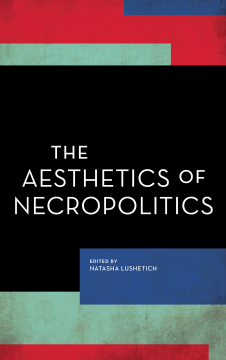
Additional Information
Book Details
Abstract
Every politics is an aesthetic. If necropolitics is the (accelerated) politics of what is usually referred to as the ‘apolitical age’, what are its manoeuvres, temporalities, intensities, textures, and tipping points? Bypassing revelatory and reconstructionist approaches – the tendency of which is to show that a particular site or practice is necropolitical by bringing its genealogy into evidence – this collection of essays by artist-philosophers and theorist curators articulates the pre-perceptual working of necropolitics through a focus on the senses, assignments of energy, attitudes, cognitive processes, and discursive frameworks.
Drawing on different yet complementary methodologies (visual, performance, affect, and network analysis; historiography and ethnography), the contributors analyse cultural fetishes, taboos, sensorial and relational processes anchored in everyday practices, or cued by specific artworks. By mapping the necropolitics’ affective cartography, they expand the concept beyond its teleological, anthropocentric, and reductive horizon of ‘making and letting die’ to include posthuman and posthumous actants, effectively arguing for the necropolitics’ transformatory, political potential.
What if politics emerges as power over death, rather than in the protection and promotion of life? This proposal – first promoted by Achille Mbembe under the name “necropolitics” - underpins this fascinating and provocative compilation. From slavery to fascism, political art to digital culture, from geographies of isolation to architectures of slaughter, the authors reconfigure the politics of past and present. These complex renditions reorient the aesthetics of politics toward its shadowy potencies: elimination, suffocation, emptiness, suffusion, erasure. Driving home the death and dismemberment of political time, this book shatters the default positivity of policy and progress.
Kennan Ferguson, Associate Professor of Political Science, University of Wisconsin-Milwaukee
This impressive collection of contributions aims to think with and against the necropolitics of our contemporaneity. Each thought experiment puts forth new and creative insights about perception, spatiality, and time at the intersections of aesthetics, politics, and our technomediated world. The result: a spatio-temporal unhinging of lived experience. This is transdisciplinary critical thinking at its finest!
Davide Panagia, Professor of Political Science, UCLA
The Aesthetics of Necropolitics is an important, timely read for scholars across the humanities and social sciences who are interested in analysis of and resistance to necropolitics. While chapters look closely at how necropolitics work, they simultaneously raise important questions about resistance in the contemporary moment. The book is a significant contribution to theories of neocroplitics in a neoliberal world.
Rachel Riedner, Associate Professor of Women's, Gender, and Sexuality Studies, George Washington University
Natasha Lushetich is Senior Lecturer in Interdisciplinary Practices & Visual Studies at LaSalle, Singapore, having previously lectured at the University of Exeter. Her research focuses on the interplay of performativity, hegemony, and biopolitics.
The Aesthetics of Necropolitics offers penetrating essays on contemporary artistic and theoretical attempts to grapple with our shiny techtoys and medicalized bodies, and the abattoirs, literal and metaphorical, of their bio-informatic production. Natasha Lushetich's Prologue locates Mbembe's term in its theoretical matrix and sets up the way in which the essays probe and twist that which "necropolitics" reveals of our world: its gendering, racializing, and sexualizing practices; the politicizing and de-politicizing of "citizens" and "refugees"; and intersecting all of them, the management of life and the dealing of death. The essays themselves produce a mixed feeling of pride and shame: pride at the courage and inventiveness of the authors, and shame at living in a world whose practices they so carefully investigate. One can only hope that such shame can provoke resistance to what so many have to see and suffer today.
John Protevi, Louisiana State University
Table of Contents
| Section Title | Page | Action | Price |
|---|---|---|---|
| Contents | iv | ||
| Acknowledgements | viii | ||
| Prologue | x | ||
| Part I: SEDIMENTATIONS: Race and Gender | 14 | ||
| Chapter One: What Is the Aesthetics of Necropolitics? | 16 | ||
| Chapter Two: Get Out: From Atlantic Slavery to Black Lives Matter | 37 | ||
| Chapter Three: Aesthetic Autonomy at the Border: Notes on Necro-Art | 54 | ||
| Part II: ABSTRACTIONS: Technological, Financial, Cultural, Scientific | 76 | ||
| Chapter Four: Inside the Corpse of Abstraction (An Apotropaic Text) | 78 | ||
| Chapter Five: Greenness: Sketching the Limits of a Normative Fetish | 96 | ||
| Chapter Six: Desire, DNA and Transgenetic Technology: Life after Necropolitics | 118 | ||
| Part III: TACTICS: Detourning the Limit, Overbidding, Mourning | 138 | ||
| Chapter Seven: Necropolitics and the Dark Comedy of the Posthuman | 140 | ||
| Chapter Eight: Dirty Your Media: Artists’ Experiments in Digital Bio-Sovereignty | 157 | ||
| Chapter Nine: Ignorance, Intimacy and Mourning in Iowa Hog Confinement | 180 | ||
| Epilogue: Archipelagoes of the Unseen | 202 | ||
| Index | 208 | ||
| About the Contributors | 215 |
